Unlocking Bitcoin Market Trends: An Introduction to Crypto Whale Tracking
In this article, we explore crypto whale tracking and Bitcoin whale monitoring, discussing their distinct methodologies and influences on market trends. These insights are key to crafting informed investment strategies.

Disclaimer: The analysis provided here offers a window into the world of Bitcoin whales and crypto whale tracking. Please remember that this represents just one element in the multifaceted realm of cryptocurrency. While data from Glassnode can provide valuable insights, it's essential to approach this information holistically, as the beginning of your personal research journey.
Crypto whales, individuals or organizations with substantial quantities of a particular cryptocurrency, can create significant market fluctuations through high-volume transactions. Tracking these whales is a complex process involving the observation of their accumulation and distribution patterns, and interpreting their behavior. By comprehending these patterns, investors can anticipate possible price swings and make strategic decisions, optimizing trading outcomes based on these influential players' activity.
This process, also known as crypto whale tracking, involves monitoring large transactions and the alert systems for such activities. Understanding these large transactions is crucial as they can significantly influence market trends. Meanwhile, monitoring Bitcoin whales specifically involves an aggregated analysis of behaviors and trends within this distinct subset of the market. Both methods provide valuable insights into market dynamics
Using Crypto Whale Tracking to Identify Accumulation and Distribution Patterns
Accumulation refers to the phase where whales are increasing their holdings, often buying large quantities of a particular cryptocurrency. A key metric here is the Supply per Whale. As seen below, The Supply per Whale metric is a metric that captures the holding behaviors of substantial Bitcoin owners. It represents the total Bitcoin supply held by addresses containing between 100 to 10k BTC, divided by the number of such addresses. This metric takes into consideration various wallet sizes, thereby better accounting for UTXO consolidation or splitting (the process of spreading sizable holdings across multiple addresses) by these large Bitcoin holders.
As we can see below, in 2023 bitcoin whales have increased there aggregate holdings by around 1.33%.
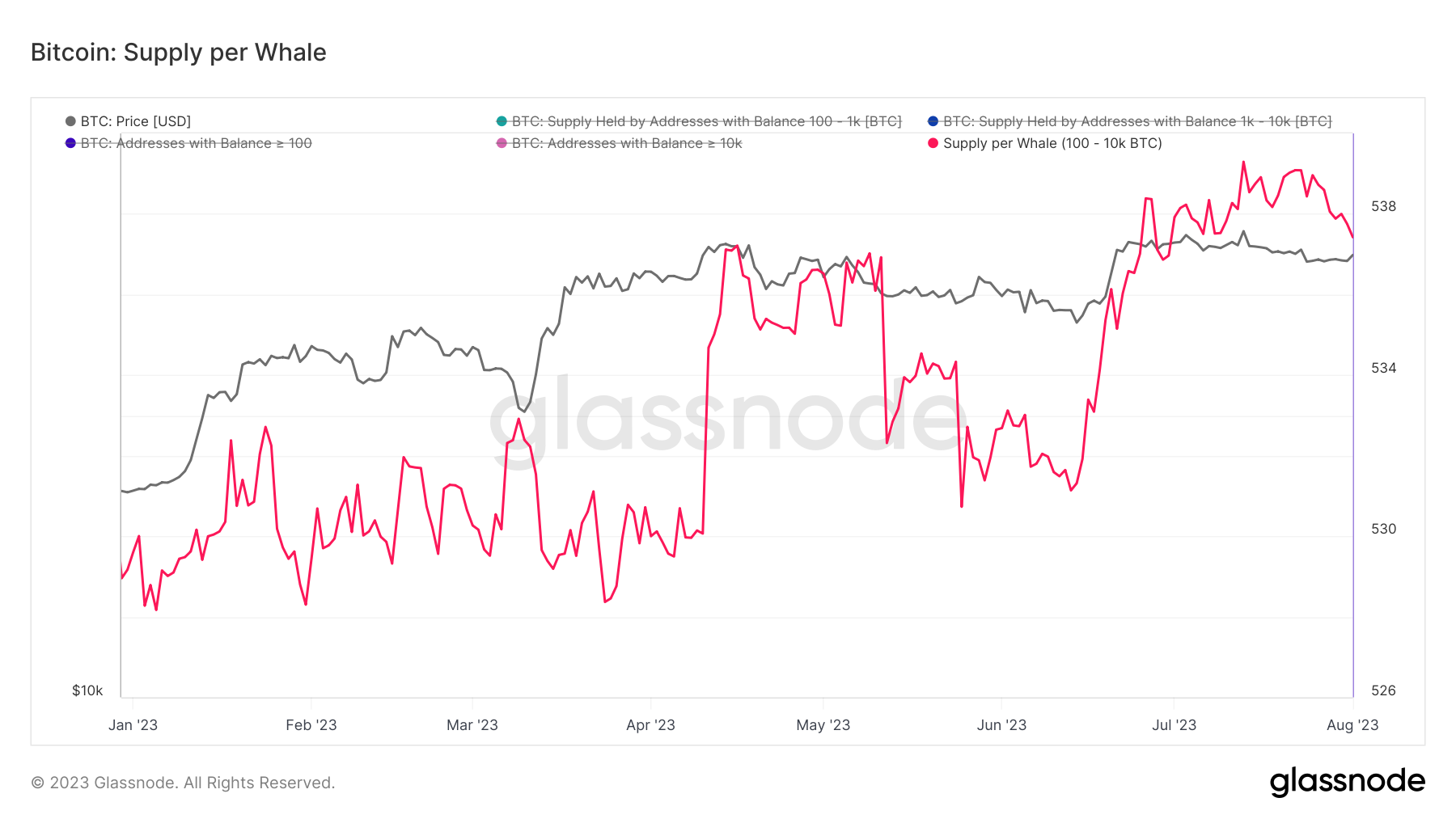
Conversely, distribution represents the phase where whales are selling off or 'distributing' their holdings. These buying and selling behaviors, when analyzed over time, can give us valuable insights into the possible future movements of cryptocurrency prices.
Before diving into deeper analysis, it's essential to understand our methodology. When discussing the Bitcoin market, specifically, we define 'whales' as entities possessing more than 1k BTC. To provide an analyses of these whales, we employ a distinct methodological approach for the following metric. We concentrate exclusively on the movement of coins into or out of exchanges that are associated with these whale entities.
This method allows us to capture more explicitly the buying and selling behaviors of these significant Bitcoin holders. Over time, shifts and trends in whale exchange activities have consistently corresponded with broader market circumstances, providing valuable context for our analysis.
The chart below provides a few significant insights:
- It outlines the total net balance maintained by the Whale Cohort, based exclusively on exchange deposits and withdrawals, represented by an orange line trace.
- It also displays the shift in the cumulative Whale Balance moving to and from exchanges over a span of 30 days, demonstrated by a purple area trace.
- By focusing solely on transactions between Whale entities and exchanges, we effectively exclude exchanges from our dataset. The resulting chart indicates a decrease in the collective balance of Whale entities by 255k BTC since May 30th.
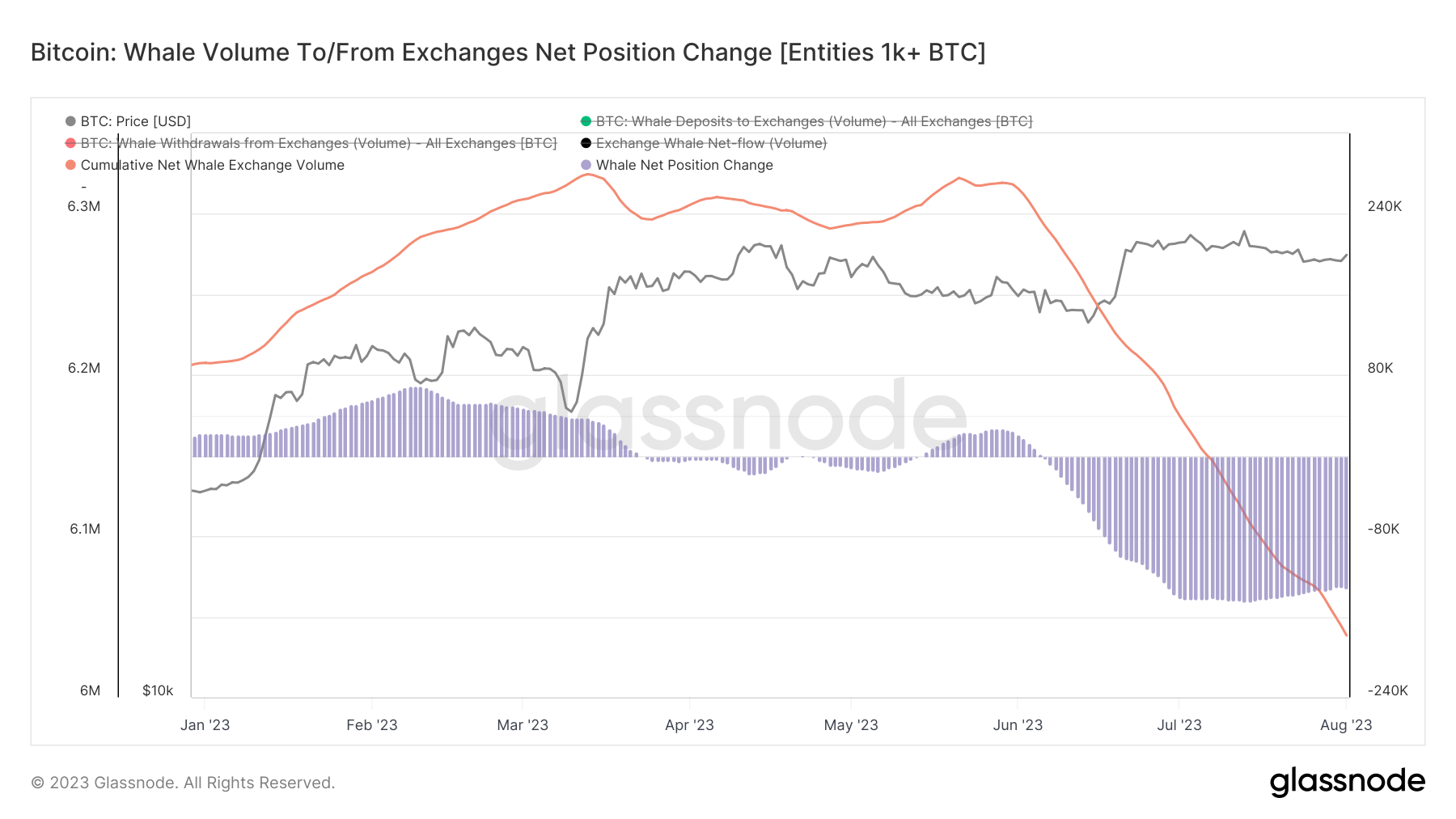
An increase in accumulation might suggest a bullish sentiment among whales, indicating that they anticipate the price of the cryptocurrency to rise.
Increasing accumulation might suggest a bullish sentiment among whales, indicating that they anticipate the price of the cryptocurrency to rise. This insight, among others, is made possible by tools such as The Bitcoin Accumulation Trend Score. A score nearing 1 implies that large entities, primarily Bitcoin whales, are on an accumulation spree, amassing more coins. Conversely, a score close to 0 suggests a phase of distribution or pause in accumulation among these entities. In 2023, we're seeing the trend score inch towards 1, indicating that entities, especially Bitcoin whales, are increasingly moving into a phase of accumulation.
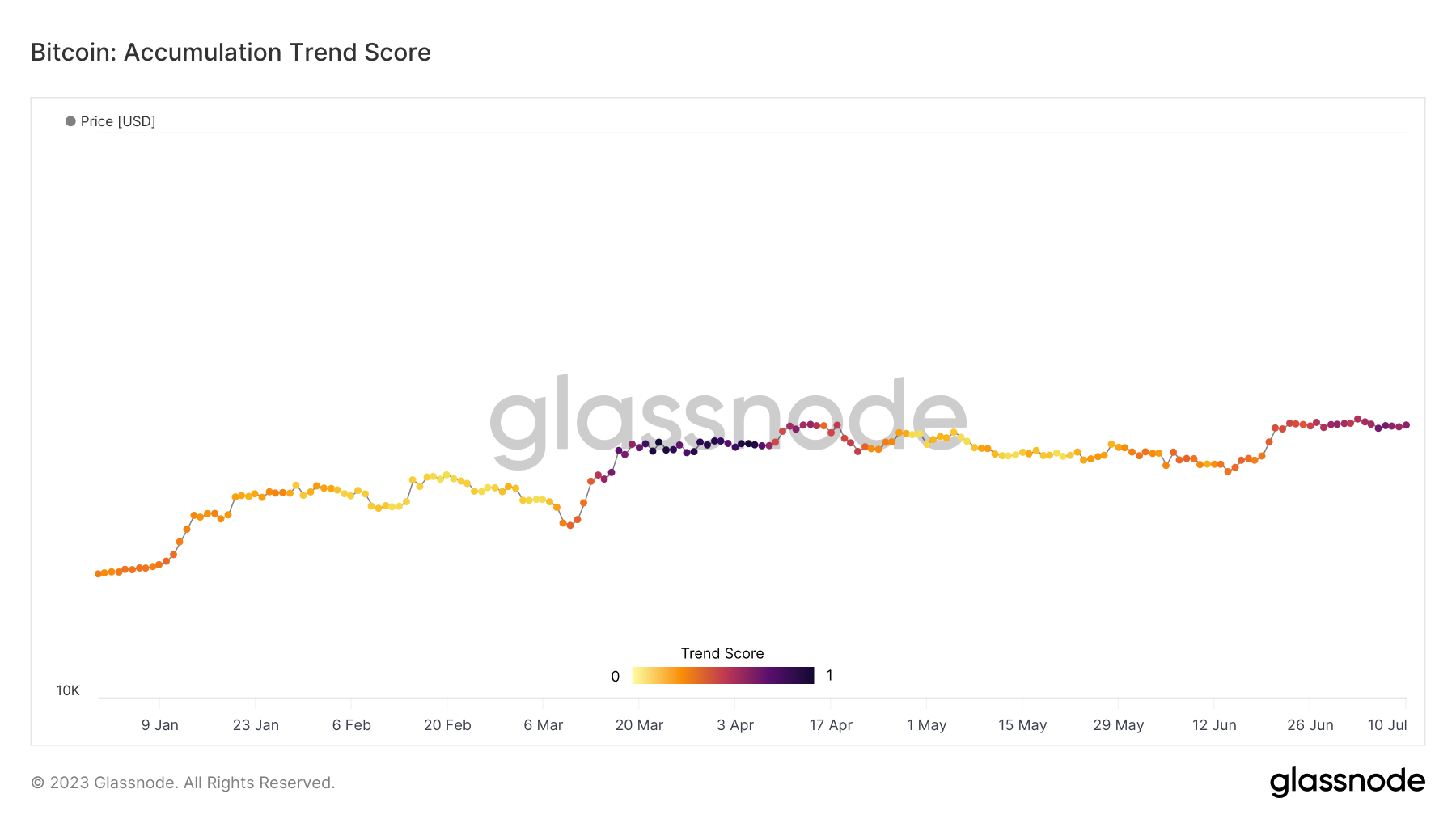
A Comparative Analysis: Bitcoin Whales vs. Crypto Whales
Tracking the behavior of crypto whales and Bitcoin whales offer unique insights into market dynamics, each with their own methodologies and focus. Both provide crucial information that can help predict market trends, though they are distinct in their applications and influences.
Crypto whale tracking revolves around the monitoring of substantial transactions and their ensuing impact on the market. These 'big moves' primarily occur in the altcoin markets, particularly within lower-cap altcoins, where a significant transaction can result in sizable price shifts. The influence of a single whale can be much more profound in these less mature, smaller market cap coins, similar to Bitcoin's early days. This makes tracking crypto whales particularly important for investors in these coins, as it can help anticipate potential price fluctuations.
In contrast, Bitcoin whale monitoring provides an aggregated analysis of the behavior of large Bitcoin holders. This broader view allows for a more comprehensive understanding of market trends within the Bitcoin ecosystem. As Bitcoin's market has matured and institutional capital has flowed in, the influence of individual whales has diminished, making an understanding of collective behavior more vital.
Take, for example, the market's response when Bitcoin first attempted to break above $30k in mid-April. We observed distribution across most wallet sizes through mid-June, followed by a shift in behavior during the second rally to $30k in late June. Smaller entities (holding less than 100 BTC) reduced their spending, while whale divisions (holding over 1k BTC) showed contrasting behavior. Whales with more than 10k BTC began distributing, and those holding between 1k and 10k BTC started accumulating at a higher rate.
This recent divergence, especially among whales with 1k to 10k BTC, may indicate the start of an accumulation phase, often a precursor to a significant price rise. The ability to spot these trends, whether for a Bitcoin investor monitoring whale activity or an altcoin investor tracking the potential sway of a single whale, can be integral to crafting a strategic response to market shifts.
The Role of On-Chain Data in Crypto Whale Tracking
In order to effectively track and understand Bitcoin whale behavior, the use of advanced analytical tools is vital. Glassnode provides a comprehensive suite of such tools that can provide an unparalleled perspective into the activities of these market movers.
At the heart of Glassnode's analytics is a clustering algorithm. Although not entity-adjusted itself, it enables the generation of entity-adjusted metrics, providing a precise view of Bitcoin whale actions. This broad range of tools enables the study of key aspects, including:
- Accumulation patterns that are currently trending.
- Metrics related to the supply held.
An entity, for context, refers to a group of addresses or wallets believed to belong to a single unique owner. The Entities Supply Distribution metric, which shows the relative distribution of the circulating supply held by entities within specific balance bands, reveals an increase in concentration. As of January 1, 2023, it was 18.87%, and as of today, it has risen to 19.34%.
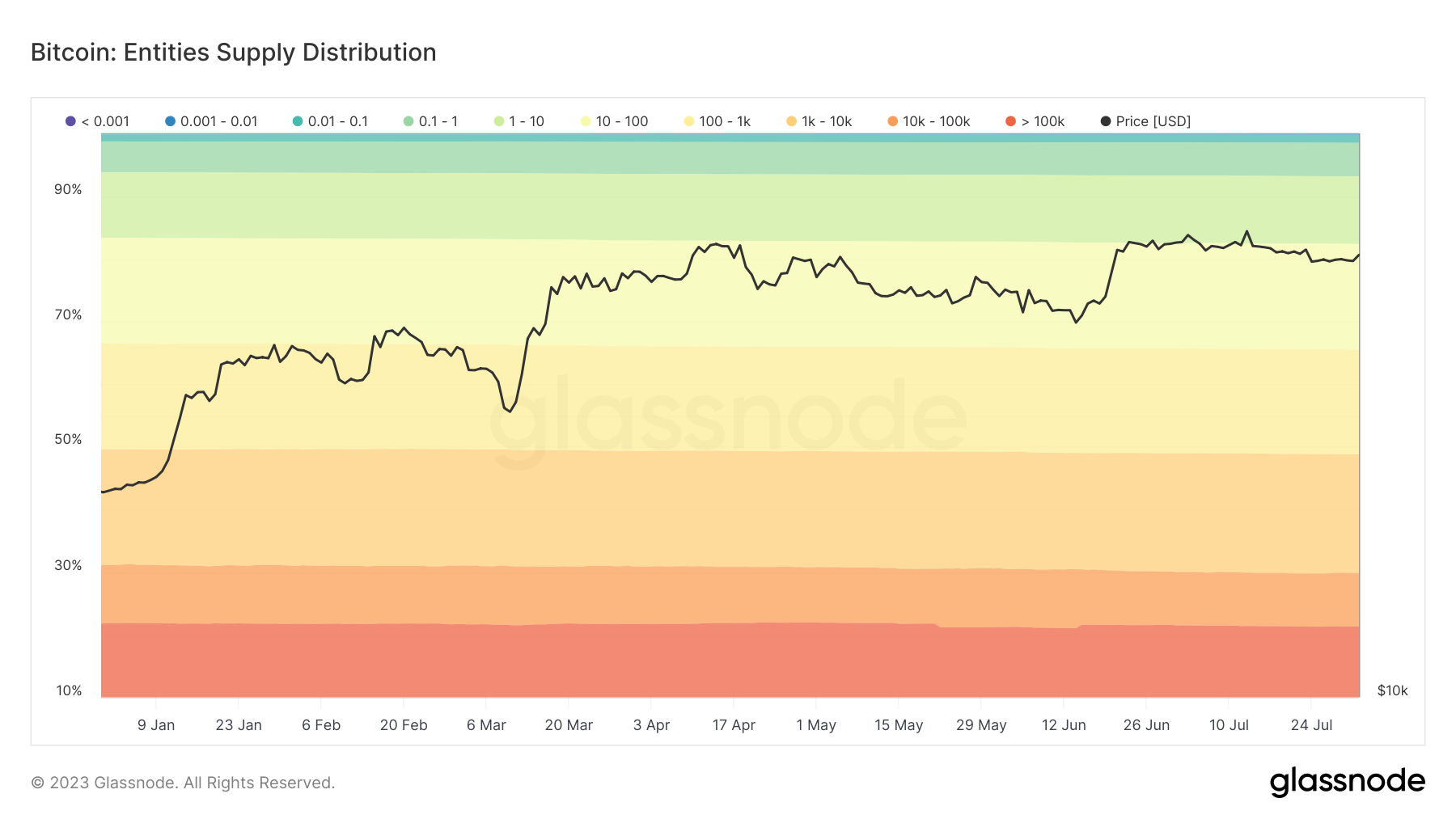
Among the crucial tools provided by Glassnode is the Bitcoin whale chart. This chart above displays the inflow and outflow volumes of BTC to exchanges associated with whale entities, defined as those holding more than 1k BTC on-chain. This information can be critical in forecasting market trends and devising investment strategies.
The whales and exchanges metric below is another important feature offered by Glassnode. This metric gives a sense of market centralization, where a high concentration could signal potential volatility. During the months of June and July this year, the daily inflow of Bitcoins to whale entities has maintained an elevated level, ranging from 4.0k to 6.5k BTC.
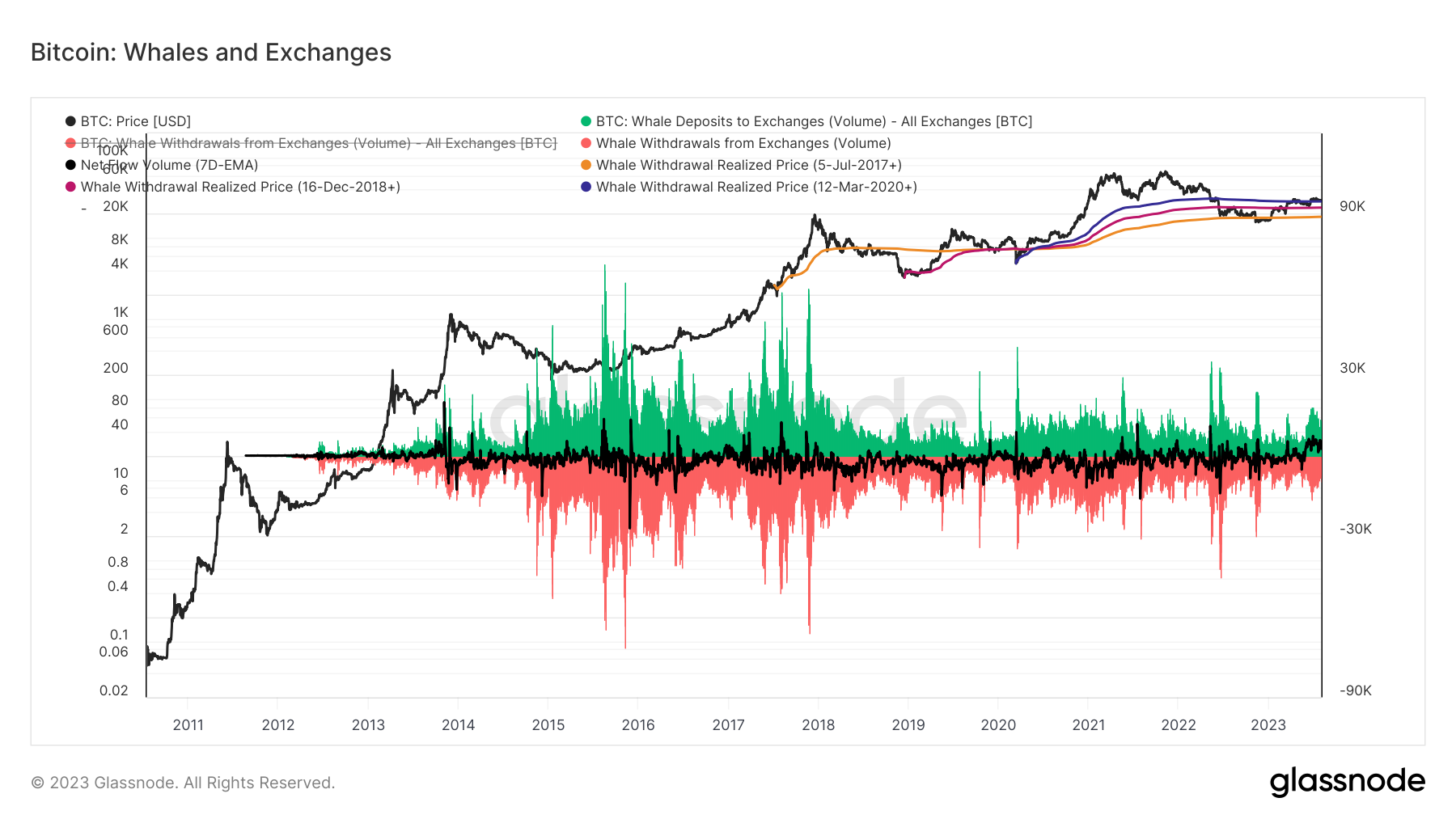
The Whale Accumulation chart provided by Glassnode is another noteworthy tool. This chart outlines the behavior of large Bitcoin holders in terms of accumulation and distribution by:
- Displaying the total supply owned by addresses holding between 100 and 10k BTC, normalized by the count of such addresses.
- Tracking UTXO consolidation or splitting, which indicates how large coin holders distribute their holdings across multiple addresses.
- Indicating whether the aggregate holdings of whale entities are increasing or decreasing.
Conclusion
In the dynamic world of cryptocurrency, 'crypto whales'—individuals or entities holding significant amounts of a particular cryptocurrency—can often be influential. Understanding their actions is crucial as their transactions can trigger or signal possible price shifts.
Utilizing analytics tools like the Whale Deposit/Withdrawal Volume Ratio Stacked dashboard, Accumulation Trend Scoreindicator, or the Yearly Absorption Rate tool can provide valuable insights into these whales' behavior. These metrics help investors gauge the whales' current holdings (participation score) and their recent accumulation or distribution (balance change score).
Monitoring these metrics allows for a better understanding of market trends, helping investors refine their investment strategies. Of note is the growing dispersion of cryptocurrency supply, a trend that signals a more diverse range of holders and speaks to the maturing and broadening acceptance of cryptocurrencies.
While Bitcoin whales serve as a prominent example, the concept extends across the crypto ecosystem. Keeping a close eye on whale activity is key to successfully navigating the cryptocurrency market.
Disclaimer: Past performance is not indicative of future results. This article is intended for informational purposes only, and it does not constitute investment advice. Always conduct thorough research.